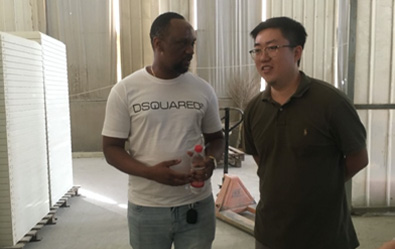loading...
- No. 9, Xingyuan South Street, Dongwaihuan Road, Zaoqiang County, Hengshui, Hebei, China
- admin@zjcomposites.com
- +86 15097380338
- Welcome to visit our website!
frp pultruded sections
Understanding FRP Pultruded Sections A Breakthrough in Material Science
Fiber Reinforced Polymer (FRP) materials have emerged as a significant innovation in engineering and construction, offering diverse benefits compared to traditional materials. Among these innovations, FRP pultruded sections stand out due to their unique manufacturing process and the advantages they bring to various applications. This article delves into the composition, manufacturing process, advantages, applications, and future prospects of FRP pultruded sections.
Composition and Properties
FRP pultruded sections are composed of a polymer matrix reinforced with fibers, typically glass, carbon, or aramid. The fibers provide high tensile strength and rigidity, while the polymer matrix ensures resistance to environmental factors such as moisture, chemicals, and UV radiation. This combination results in lightweight, corrosion-resistant materials that outperform conventional materials like steel and concrete in many applications.
One of the most striking features of FRP materials is their high strength-to-weight ratio. This characteristic makes them especially appealing for applications where weight savings are crucial, such as in aerospace and automotive industries. Additionally, FRP has superior thermal and electrical insulation properties, making it suitable for environments where electrical conductivity and thermal expansion are concerns.
The Pultrusion Process
The production of FRP pultruded sections involves a process called pultrusion, where continuous fibers are pulled through a resin bath and then through a heated die. The die shapes the resin-impregnated fibers into the desired cross-sectional form, which then solidifies as it cools. This continuous manufacturing process allows for the production of long, uniform sections with high accuracy and repeatability.
The pultrusion process offers several advantages over traditional manufacturing methods. For instance, it reduces material waste, as the process only uses what is needed to create the end product. Moreover, the consistent quality and properties of the final product ensure that engineers can rely on FRP pultruded sections for structural applications.
Advantages of FRP Pultruded Sections
FRP pultruded sections bring a host of advantages to various industries
1. Corrosion Resistance Unlike metal structures, FRP does not rust, making it an ideal choice for applications in harsh environments, such as marine, chemical processing, and wastewater treatment.
frp pultruded sections

2. Lightweight The lightweight nature of FRP sections facilitates easier handling and installation, reducing labor costs and transportation expenses.
3. Durability FRP materials can withstand extreme weather conditions, fluctuations in temperature, and chemical exposure, leading to lower lifecycle costs due to reduced maintenance needs.
4. Customizability The pultrusion process allows for the creation of multiple shapes and sizes tailored to specific application requirements, enabling engineers to design solutions that fit unique project needs.
5. Sustainability As a result of their long service life and low maintenance requirements, FRP materials contribute to more sustainable construction practices.
Applications of FRP Pultruded Sections
The versatility of FRP pultruded sections allows for their use in a wide range of applications. In the construction industry, they are used in bridges, railings, and structural components, providing safer and more durable alternatives to traditional materials. The electrical and telecommunications sectors utilize FRP for cable trays and utility poles, where their electrical insulation properties are advantageous.
In specialized industries, such as oil and gas, FRP pultruded sections are employed in offshore platforms and pipelines, where exposure to corrosive substances poses a significant challenge for conventional materials. Moreover, they find applications in recreational and sports equipment, such as boat hulls and stay rods for wind turbines, demonstrating their adaptability across various fields.
Future Prospects
The future of FRP pultruded sections looks promising, driven by advancements in material science and increasing demand for sustainable solutions. Ongoing research into new fiber-reinforcement technologies and resins will likely enhance the performance and lower the costs of FRP materials, opening new avenues for their use.
As industries continue to seek out sustainable, lightweight, and durable alternatives to traditional materials, FRP pultruded sections will play a pivotal role in shaping the future of engineering and construction. Their ability to meet the needs of modern infrastructure while minimizing environmental impact positions them as a key player in the evolving landscape of material technologies.
In conclusion, FRP pultruded sections represent a significant advancement in material science, with widespread applications across various sectors. Their durability, versatility, and environmental resilience make them a compelling choice for engineers and architects looking to innovate and enhance structural integrity in a sustainable manner.
-
The Rise of FRP Profiles: Strong, Lightweight, and Built to LastNewsJul.14,2025
-
SMC Panel Tanks: A Modern Water Storage Solution for All EnvironmentsNewsJul.14,2025
-
GRP Grating: A Modern Solution for Safe and Durable Access SystemsNewsJul.14,2025
-
Galvanized Steel Water Tanks: Durable, Reliable, and Ready for UseNewsJul.14,2025
-
FRP Mini Mesh Grating: The Safer, Smarter Flooring SolutionNewsJul.14,2025
-
Exploring FRP Vessels: Durable Solutions for Modern Fluid HandlingNewsJul.14,2025
-
GRP Structures: The Future of Lightweight, High-Performance EngineeringNewsJun.20,2025
